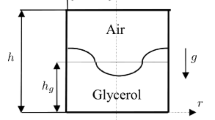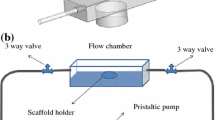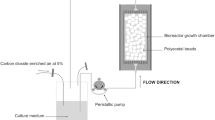Abstract
Tissue cells are known to be sensitive to mechanical stresses imposed on them by agitation in bioreactors. The amount of agitation provided in a microcarrier or suspension bioreactor should be only enough to provide an effective homogeneity. Three distinct flow regions can be identified in the reactor: bulk turbulent flow, bulk laminar flow, and boundary-layer flows. Possible mechanisms of cell damage are examined by analyzing the motion of microcarriers or free cells relative to the surrounding fluid, to each other, and to moving or stationary solid surfaces. The primary mechanisms of cell damage appear to result from (a) direct interaction between microcarriers and turbulent eddies, (b) collisions between microcarriers in turbulent flow, and (c) collisions against the impeller or other stationary surfaces. If the smallest eddies of turbulent flow are of the same size as the microcarrier beads, they may cause high shear stresses on the cells. Eddies the size of the average interbead spacing may cause bead-bead collisions which damage cells. The severity of the collisions increases when the eddies are also of the same size as the beads. Bead size and the interbead distance are virtually equal in typical microcarrier suspensions. Impeller collisions occur when the beads cannot avoid the impeller leading edge as it advances through the liquid. The implications of the results of this analysis on the design and operation of tissue culture bioreactors are also discussed.
Similar content being viewed by others
Abbreviations
- d cm:
-
particle diameter
- d icm:
-
impeller diameter
- d scm:
-
average surface-to-surface spacing between particles
- E cg cm2 s−2 :
-
energy of particle-to-particle collisions
- E c,ig cm2 s−2 :
-
energy of particle to impeller collisions
- g 980 cm s−2 :
-
gravitational constant
- k cm−1 :
-
surface to volume ratio term, Eq. (10)
- l ecm:
-
eddy size
- m g:
-
particle mass
- n s−1 :
-
impeller rotational speed
- n bcm−3 :
-
number of particles per unit volume
- n B :
-
number of impeller blades
- N ccm−3 s−1 :
-
particle-particle collision frequency per unit volume
- N c,ii cm−3s−1 :
-
frequency of particle to impeller collisions per unit volume
- N p :
-
power number
- Re :
-
Reynolds number
- P g cm s −1 :
-
agitator power consumption
- r cm:
-
radial distance in spherical coordinate system
- R cm:
-
particle radius
- R icm:
-
impeller leading edge radius
- S ucm−1 :
-
surface area of beads per unit volume
- SC g cm−1 s−3 :
-
severity of particle-to-particle collisions per unit volume
- SC i g cm−1s−3 :
-
severity of particle to impeller collisions
- t s:
-
time between particle collisions
- νb,r cm s−1 :
-
root mean square relative velocity between neighboring particles
- νe cm s−1 :
-
velocity of the smallest eddies
- νcm s−1 :
-
fluid velocity
- νt cm s−1 :
-
bead terminal velocity
- νφ cm s−1 φ:
-
component of fluid velocity around a spherical particle
- νt8 cm s−1 :
-
fluid approach velocity
- V cm3 :
-
reactor liquid volume
- V b,tot cm3 :
-
total bead volume in reactor
- w cm:
-
impeller blade width
- x cm:
-
distance from impeller leading edge
- y cm:
-
distance from impeller surface
- α :
-
volume fraction occupied by particles
- β g cm−1 s−1 :
-
parameter in shear stress definition
- γ s−1 :
-
shear rate
- δ cm:
-
boundary layer thickness
- δ l,δt :
-
laminar and turbulent δ, respectively
- ɛ cm2 s−3 :
-
energy dissipation rate per unit mass
- η cm:
-
size of smallest eddies
- θ :
-
angle in spherical coordinate system
- μ g cm−1 s−1 :
-
viscosity
- ν cm2 s−1 :
-
kinematic viscosity
- ρ f g cm−3 :
-
fluid density
- ϱb g cm−3 :
-
particle density
- τ g cm−1 s−2 :
-
shear stress
- τ w,l :
-
wall τ in laminar boundary layer
- τ w,t :
-
wall τ in turbulent boundary layer
- φ :
-
angle in spherical coordinate system
- ψ :
-
stream function
- avg:
-
average
- b :
-
bead
- f :
-
fluid
- max:
-
maximum
References
Glacken, M. W.; Fleischaker, R. J.; Sinskey, A. J.: Mammalian cell culture: Engineering principles and scale-up. Trends Biotech. 1 (1983) 102–108
Feder, J.; Tolbert, W. R.: The large scale culture of mammalian cells. Sci. Am. 248 (1983) 36–43
Margaritis, A.; Wallace, J. B.: Novel bioreactor systems and their applications. Biotechnol. 2 (1984) 447–453
Midier, M., Jr.; Finn, R. K.: A model system for evaluating shear in the design of stirred fermentors. Biotechnol. Bioeng. 8 (1966) 71–84
Hirtenstein, M.; Clark, J.: In: Richards, R.; Rajan, K. (Eds.): Tissue culture in medical research. Oxford: Pergamon Press (1980)
Sinskey, A. J.; Fleischaker, R. J.; Tyo, M. A.; Giard, D. J.; Wang, D. I. C.: Production of cell-derived products: Virus and interferon. Ann. NY Acad. Sci. 369 (1981) 47–59
Croughan, M. S.; Wang, D. I. C.; Hamel, J.-F.: Fluid shear effects on animal cells grown in microcarrier cultures. Presented at AIChE National Meeting, Chicago, November 1985
Stathopoulos, N. A.; Hellums, J. D.: Shear stress effects on human embryonic kidney cells in vitro. Biotechnol. Bioeng. 27 (1985) 1021–1026
Frangos, J. A.; Eskin, S. G.; McIntire, L. V.; Ives, C. L.: Flow effects on prostacyclin production by cultured human endothelial cells. Sci. 227 (1985) 1477–1479
Fleischaker, R. J., Jr.; Sinskey, A. J.: Oxygen demand and supply in cell culture. Eur. J. Appl. Microbiol. 12 (1981) 193–197
Bird, R. B.; Stewart, W. E.; Lightfoot, E. N.: Transport phenomena, pp. 56–60. NY: Wiley & Sons 1960
Cooney, C. L.; Koplov, H. M.; Haggstrom, M.: Transient phenomena in continuous culture. In: Calcott, P. H. (Ed.): Continuous culture of cells. Florida: CRC Press, Boca Raton 1981
Harrison, D. E. F.; Topiwala, H. H.: Transient and oscillatory states of continuous culture. Adv. Biochem. Eng. 3 (1974) 67–220
Hansford, G. S.; Humphrey, A. E.: Effect of equipment scale and degree of mixing on continuous fermentation yield at low dilution rates. Biotechnol. Bioeng. 8 (1966) 85–96
Kolmogorov, D. N.; C. R. (Doklady) Acad. Sci. U.S.S.R., N.S. 30 (1941) 301–305
Hinze, J. O.: Turbulent fluid and particle interaction. Prog. Heat Mass Transfer 6 (1971) 433–452
Friedlander, S. K.: Behavior of suspended particles in a turbulent fluid. AIChE J. 3 (1957) 381–385
Panchev, S.: Random functions and turbulence, pp. 144–152. New York: Pergamon Press 1971
Nagata, S.: Mixing — principles and applications, pp. 138–164. New York: Halsted Press 1975
Giard, D. J.; Loeb, D. H.; Thilly, W. G.; Wang, D. I. C.; Levine, D. W.: Human interferon production with diploid fibroblast cells grown on microcarriers. Biotechnol. Bioeng. 21 (1979) 433–442
Soo, S. L.: Fluid dynamics of multiphase systems, p. 263. Mass.: Blaisdell Publ. Co., Waltham 1967
Lee, S. L.; Durst, F.: On the motion of particles in turbulent duct flows. Int. J. Multiphase Flow 8 (1982) 125–146
Microcarrier cell culture — principles and methods. Uppsala, Sweden: Pharmacia Fine Chemicals AB 1981
Einav, S.; Lee, S. L.: Particles migration in laminar boundary layer flow. Int. J. Multiphase Flow 1 (1973) 73–88
Nagata, S., op. cit. p. 36
Perry, R. H.; Chilton, C. H. (Eds.): Chemical engineers' handbook, 5th ed., p. 3–247. New York: McGraw-Hill 1973
Sather, N. F.; Lee, K. J.: Viscosity of concentrated suspensions of spheres. Prog. Heat Mass Trans. 6 (1972) 575–589
Placek, J.; Tavlarides, L. L.: Turbulent flow in stirred tanks. Part I: Turbulent flow in the impeller region. AIChE J. 31 (1985) 1113–1120
Schlichting, H.: Boundary layer theory, 7th ed., pp. 636–640. New York: McGraw-Hill 1979
Ibid pp. 695–696
Ibid pp. 135–144
Brenner, H.: Particles in low Reynolds number flows. Prog. Heat Mass Transfer 6 (1971) 509–574
Saffman, P. G.: The lift on a small sphere in slow shear flow. J. Fluid Mech. 22 (1965) 385–400
Immich, H.: Impulsive motion of a suspension: Effect of antisymmetric stresses and particle rotation. Int. J. Multiphase Flow 6 (1980) 441–471
Cox, R. G.; Zia, I. Y. Z.; Mason, S. G.: Particle motions in sheared suspensions: XXV. Streamline around cylinders and spheres. J. Colloid Interface Sci. 27 (1968) 7–18
Adamczyk, Z.; van de Ven, T. G. M.: Pathlines around freely rotating spheroids in simple shear flow. Int. J. Multiphase Flow 9 (1983) 203–217
Goldman, A. J.; Cox, R. G.; Brenner, H.: Slow viscous motion of a sphere parallel to a plane wall-II. Couette flow. Chem. Eng. Sci. 22 (1967) 653–660
Eichhorn, R.; Small, S.: Experiments on the lift and drag of spheres suspended in a Poiseuille flow. J. Fluid Mech. 20 (1964) 513–527
Spielman, L. A.: Particle capture from low-speed laminar flows. Ann. Rev. Fluid Mech. 9 (1977) 297–319
Davies, C. N.: Air filtration, chap. 3. New York: Academic Press 1973
Schlichting, H., op. cit. p. 39
Bird, R. B. et al., op. cit. p. 136
Schlichting, H., op. cit., p. 97–98
Nagata, S., op. cit., p. 10
Mizrahi, A.: Oxygen in human lymphoblastoid cell line cultures and effect of polymers in agitated and aerated cultures. Dev. Biol. Stds. 55 (1984) 93–102
De Bruyne, N. A.: A high efficiency stirrer for suspension cell culture with or without microcarriers. Adv. Exp. Med. Biol. 172 (1984) 139–149
Author information
Authors and Affiliations
Rights and permissions
About this article
Cite this article
Cherry, R.S., Papoutsakis, E.T. Hydrodynamic effects on cells in agitated tissue culture reactors. Bioprocess Eng. 1, 29–41 (1986). https://doi.org/10.1007/BF00369462
Received:
Issue Date:
DOI: https://doi.org/10.1007/BF00369462




